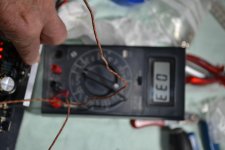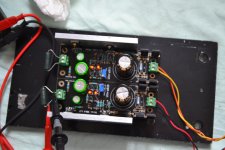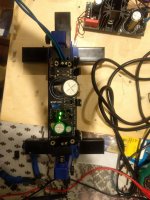That was an older quote with those handy resistors I had actually used in the experiment. 3.9R rather in the negative.negative rail R1 should be 3.3? i thought it was 3.8 for the Soekris dac.
I can make up a 1R83 resistor from my parts bin, I'll try that tomorrow and let you know the outcome. Thanks.
With some spare 10R? 10R//2R2=1.8032R
thank you salas. i just bought this desoldering station as well but the boards and the components are already ruined
you see the hole for C3 is filled with solder? i set the soldering iron to 825 and still no solder comes out. it is like a rock
Your boards aren't terminally ruined. They look battered by having fought a battle and many holes are filled with RoHS solder BUT there aren't any lifted pads in your photos. Tough as nails. They can be restored with the vacuum gun clearing the holes. Also the cleaning of flux and other residue with isopropyl alcohol will not only help the looks but the rework process too.
Regarding good practice with a vacuum gun so not to clog it up:
-Use the long wire cleaning tools provided before and after each session only when its up to a high set temperature.
-Don't pull the trigger before the gun reaches set temperature. So it will not pull medium hot solder bits already at the nozzle further up the tube where its cooler. They must not get a chance to solidify there before reaching the collection chamber. Cheap stations heat up slowly at power on so have patience.
-Keep on the trigger for little longer after a pad has cleared so all the solder moves up to the chamber, not any last bit to be remaining in the tube.
-The display shows temperature not sensed directly at the nozzle's tip but further up so be generous with the setting. What you see is NOT what you get at the nozzle's tip by enough tolerance (especially true for cheap stations). Its only set ok when it feels ok working with each different board and solder composition.
-Use good quality leaded solder in general. Add some to the unleaded solder filled pads. It will help softening it up for rework.
-Good luck
Yes dual mono. Replacing bib 1.1's.
It will be interesting to know your results with that move on the DCG3
is it ok to use 1N4004 in place of the 4 diodes?
For not too high CC that does not get them much hot such size diodes are alright
oh my god the desoldering station works beautifully. how did i ever live without it?
 At what shown temp you work the gun for this board?
At what shown temp you work the gun for this board?At what shown temp you work the gun for this board?
at first i set it at the highest because i wanted to see what it does. but then i realized that i can desolder at 445. for the difficult ones 465 did it.
//////////////////
Attachments
at first i set it at the highest because i wanted to see what it does. but then i realized that i can desolder at 445. for the difficult ones 465 did it.
It could be 20-30C lower than shown if accurately verified right at the tip. Or its reading preciser than we think, but precision does not matter since it has the range to do the job. All it matters for diy is we get a repeatable reading to memorize effective settings for various situations. Professionals under contract work need cal certificates for almost all of their gear of course.
i desoldered, found the faulty components and resoldered everything back in an hour. when i get the new boards that a member here generously offered to sell to me at cost i will build those as well. this will be a practice board.
Great. But don't test it for too long without sinks. At least use some clip on handy ones. Depending on the CC setting the MOSFETS can go too hot or reach their destruction max swiftly when unassisted. BTW what were the main faulty components you confirmed after the cross rails shorted MOSFETS incident?
The Rf, R3 and M1 and M2 were definitely fried, it is difficult to know if the rest were damaged due to me not insulating the transistors upon powering on or were damaged when i was trying to take them out because many transistors lost their legs in the process. but i had to also order Q1 and Q3 and replace those too. this is for the negative rail, the positive still remains to be seen.
Yesterday finished assembly of ULTRABIB shunts I am going to use powering a new phonostage.
The boards from Salas are really good to work with, user friendly, easy to solder and full-on attention to detail.
Later will post pics of the contraption and report with listening impressions.
Congratulations and thank you for sharing.
The boards from Salas are really good to work with, user friendly, easy to solder and full-on attention to detail.
Later will post pics of the contraption and report with listening impressions.
Congratulations and thank you for sharing.
I've built a 18V positive and negative ultrabib to power my phono preamp and wondered if the 0V terminal can be connected to earth as it's currently floating. I'm afraid to try it in case I blow a component.
The reason I'm asking is getting hum problem and wondered earthing the phono preamp would cure it. Thanks.
The reason I'm asking is getting hum problem and wondered earthing the phono preamp would cure it. Thanks.
- Home
- Amplifiers
- Power Supplies
- Salas SSLV1.3 UltraBiB shunt regulator


